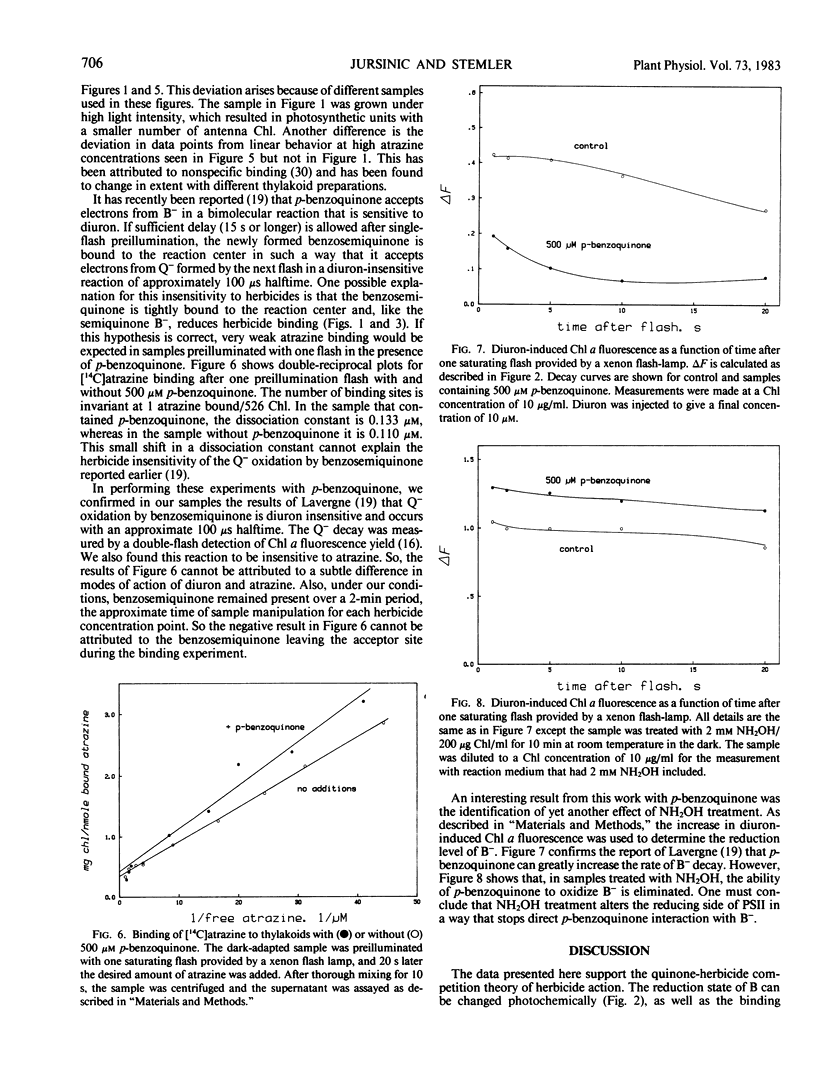Abstract
One hypothesis of triazine-type herbicide action in photosynthetic material is that the herbicide molecule competes with a secondary quinone acceptor, B, for a binding site at the reaction center of photosystem II. The binding affinity of B has been suggested to change with its level of reduction, being most strongly bound in its semiquinone form. To test this hypothesis, [14C]atrazine binding studies have been carried out under different photochemically induced levels of B reduction in Pisum sativum. It is found that herbicide binding is reduced in continuously illuminated samples compared to dark-adapted samples. Decreased binding of atrazine corresponds to an increase in the semiquinone form of B. With flash excitation, the herbicide binding oscillates with a cycle of two, being low on odd-numbered flashes when the amount of semiquinone form of B is greatest. Treatment with NH2OH was found to significantly decrease the strength of herbicide binding in the dark as well as stop the ability of p-benzoquinone to oxidize the semiquinone form of B. It is suggested that the mode of action of NH2OH is disruption of quinones or their environment on both the oxidizing and reducing sides of photosystem II. Herbicide binding was found to be unaltered under conditions when p-benzosemiquinone oxidation of the reduced primary acceptor, Q−, is herbicide insensitive; weak herbicide binding cannot explain this herbicide insensitivity. It is concluded that the quinone-herbicide competition theory of herbicide action is correct. Also, since quinones are lipophilic the importance of the lipid composition of the thylakoid membrane in herbicide interactions is stressed.
Full text
PDF





Selected References
These references are in PubMed. This may not be the complete list of references from this article.
- Bennoun P., Joliot A. Etude de la photooxydation de l'hydroxylamine par les chloroplastes d'epinards. Biochim Biophys Acta. 1969 Sep 16;189(1):85–94. doi: 10.1016/0005-2728(69)90229-1. [DOI] [PubMed] [Google Scholar]
- Bouges-Bocquet B. Electron transfer between the two photosystems in spinach chloroplasts. Biochim Biophys Acta. 1973 Aug 31;314(2):250–256. doi: 10.1016/0005-2728(73)90140-0. [DOI] [PubMed] [Google Scholar]
- Bouges B. Action de faibles concentrations d'hydroxylamine sur l'émission d'oxygène des algues Chlorella et des chloroplastes d'épinards. Biochim Biophys Acta. 1971 Apr 6;234(1):103–112. doi: 10.1016/0005-2728(71)90135-6. [DOI] [PubMed] [Google Scholar]
- Bowes J., Crofts A. R., Arntzen C. J. Redox Reactions on the reducing side of photosystem II in chloroplasts with altered herbicide binding properties. Arch Biochem Biophys. 1980 Apr 1;200(2):303–308. doi: 10.1016/0003-9861(80)90359-8. [DOI] [PubMed] [Google Scholar]
- Burke J. J., Wilson R. F., Swafford J. R. Characterization of Chloroplasts Isolated from Triazine-Susceptible and Triazine-Resistant Biotypes of Brassica campestris L. Plant Physiol. 1982 Jul;70(1):24–29. doi: 10.1104/pp.70.1.24. [DOI] [PMC free article] [PubMed] [Google Scholar]
- Cheniae G. M., Martin I. F. Effects of Hydroxylamine on Photosystem II: I. Factors Affecting the Decay of O(2) Evolution. Plant Physiol. 1971 Apr;47(4):568–575. doi: 10.1104/pp.47.4.568. [DOI] [PMC free article] [PubMed] [Google Scholar]
- Den Haan G. A., Gorter De Vries H., Duysens L. N. Correlation between flash-induced oxygen evolution and fluorescence yield kinetics in the 0 to 16 mus range in Chlorella pyyrenoidosa during incubation with hydroxylamine. Biochim Biophys Acta. 1976 May 14;430(2):265–281. doi: 10.1016/0005-2728(76)90084-0. [DOI] [PubMed] [Google Scholar]
- Jursinic P., Warden J., Govindjee A major site of bicarbonate effect in system II reaction. Evidence from ESR signal IIvf, fast fluorescence yield changes and delayed light emission. Biochim Biophys Acta. 1976 Aug 13;440(2):322–330. doi: 10.1016/0005-2728(76)90066-9. [DOI] [PubMed] [Google Scholar]
- Khanna R., Pfister K., Keresztes A., van Rensen J. J., Govindjee Evidence for a close spatial location of the binding sites for CO2 and for photosystem II inhibitors. Biochim Biophys Acta. 1981 Jan 14;634(1):105–116. doi: 10.1016/0005-2728(81)90131-6. [DOI] [PubMed] [Google Scholar]
- Pfister K., Radosevich S. R., Arntzen C. J. Modification of Herbicide Binding to Photosystem II in Two Biotypes of Senecio vulgaris L. Plant Physiol. 1979 Dec;64(6):995–999. doi: 10.1104/pp.64.6.995. [DOI] [PMC free article] [PubMed] [Google Scholar]
- Pillai P., John J. B. Lipid composition of chloroplast membranes from weed biotypes differentially sensitive to triazine herbicides. Plant Physiol. 1981 Sep;68(3):585–587. doi: 10.1104/pp.68.3.585. [DOI] [PMC free article] [PubMed] [Google Scholar]
- Renger G. The action of 3-(3,4-dichlorophenyl)-1,1-dimethylurea on the water-splitting enzyme system Y of photosynthesis. Biochim Biophys Acta. 1973 Jul 26;314(1):113–116. doi: 10.1016/0005-2728(73)90070-4. [DOI] [PubMed] [Google Scholar]
- Rich P. R. A generalised model for the equilibration of quinone pools with their biological donors and acceptors in membrane-bound electron transfer chains. FEBS Lett. 1981 Aug 3;130(2):173–178. doi: 10.1016/0014-5793(81)81113-1. [DOI] [PubMed] [Google Scholar]
- Sadewasser D. A., Dilley R. A. A dual requirement for plastoquinone in chloroplast electron transport. Biochim Biophys Acta. 1978 Feb 9;501(2):208–216. doi: 10.1016/0005-2728(78)90027-0. [DOI] [PubMed] [Google Scholar]
- Tischer W., Strotmann H. Relationship between inhibitor binding by chloroplasts and inhibition of photosynthetic electron transport. Biochim Biophys Acta. 1977 Apr 11;460(1):113–125. doi: 10.1016/0005-2728(77)90157-8. [DOI] [PubMed] [Google Scholar]
- Warden J. T., Blankenship R. E., Sauer K. A flash photolysis ESR study of photosystem II signal IIvf, the physiological donor to P-680+. Biochim Biophys Acta. 1976 Mar 12;423(3):462–478. doi: 10.1016/0005-2728(76)90201-2. [DOI] [PubMed] [Google Scholar]
- Wollman F. A. Determination and modification of the redox state of the secondary acceptor of photosystem II in the dark. Biochim Biophys Acta. 1978 Aug 8;503(2):263–273. doi: 10.1016/0005-2728(78)90187-1. [DOI] [PubMed] [Google Scholar]
- Wraight C. A., Stein R. R. Redox equilibrium in the acceptor quinone complex of isolated reaction centers and the mode of action of O-phenanthroline. FEBS Lett. 1980 Apr 21;113(1):73–77. doi: 10.1016/0014-5793(80)80498-4. [DOI] [PubMed] [Google Scholar]
- Zilinskas B. A., Govindjee Silicomolybdate and silicotungstate mediated dichlorophenyldimethylurea-insensitive photosystem II reaction: electron flow, chlorophyll a fluorescence and delayed light emission changes. Biochim Biophys Acta. 1975 May 15;387(2):306–319. doi: 10.1016/0005-2728(75)90112-7. [DOI] [PubMed] [Google Scholar]


